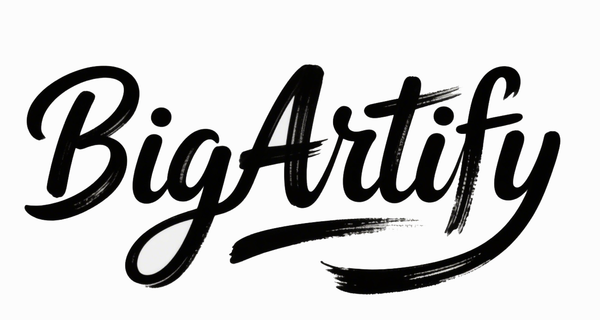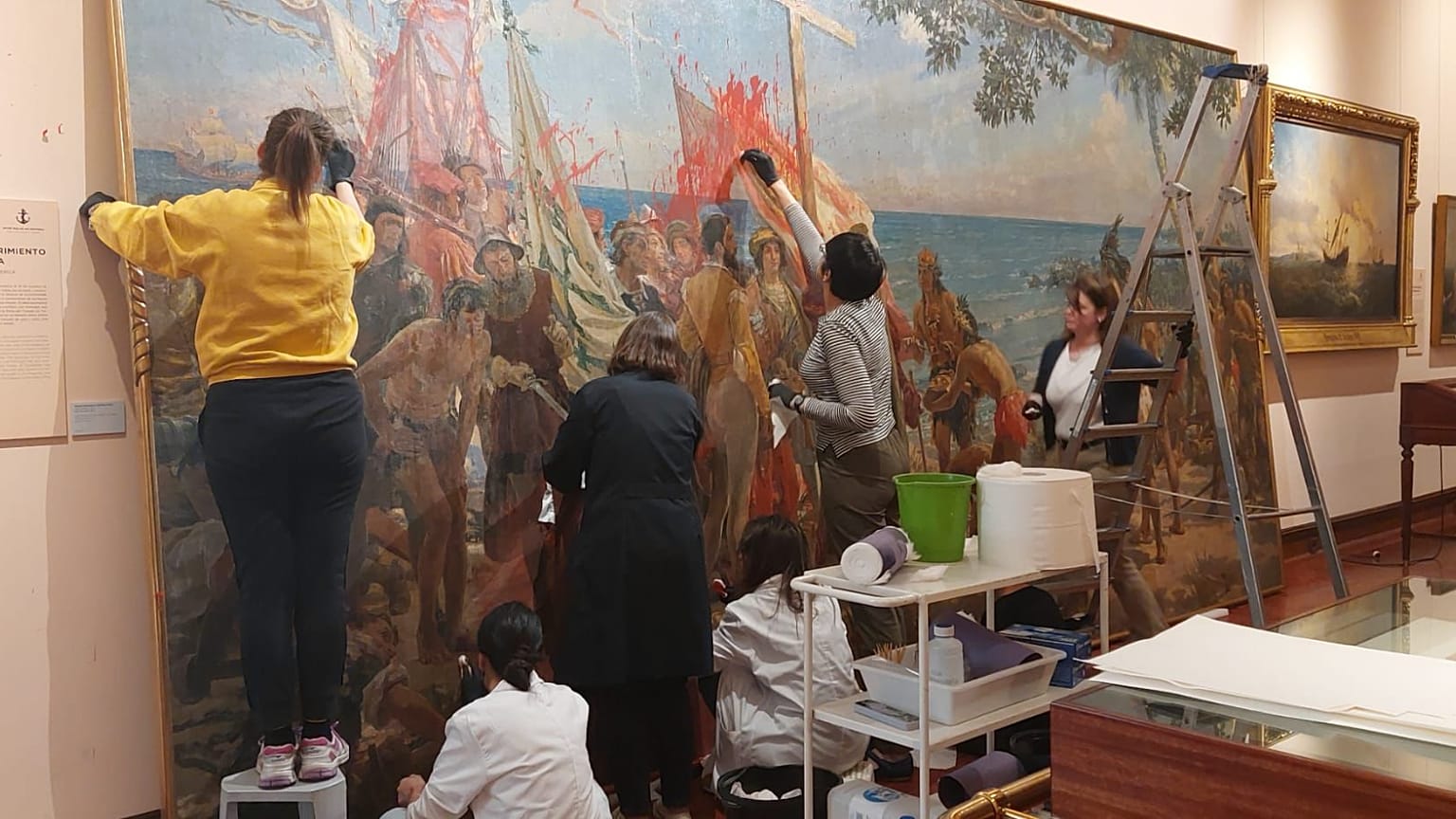Climate Activists Deface Christopher Columbus Painting on Day Marking His Arrival to Americas
In a bold act of protest coinciding with Spain's National Day, two climate activists from the group Futuro Vegetal hurled biodegradable red paint onto a historic painting depicting Christopher Columbus at Madrid's Naval Museum. The incident occurred on October 12, 2025, a date that commemorates Columbus's arrival in the Americas in 1492, sparking immediate arrests and reigniting debates over colonial legacies, environmental justice, and the tactics of modern activism. The targeted artwork, José Garnelo's 1892 "First Tribute to Christopher Columbus," suffered damage primarily on its left side, though museum officials quickly intervened, detaining the protesters until police arrived.
The Naval Museum, located in the heart of Madrid and managed by Spain's Ministry of Defense, houses an extensive collection chronicling the nation's maritime history. For more on its exhibits, visitors can explore the official Naval Museum website. Garnelo's painting, created to mark the 400th anniversary of Columbus's voyage, portrays the explorer receiving homage from indigenous peoples, a romanticized scene that activists argue glosses over the violent realities of colonization. The red paint, symbolizing blood, was accompanied by a banner reading "October 12, nothing to celebrate," as the protesters decried Spain's holiday as a glorification of "centuries of oppression and genocide against the Indigenous peoples of Abya Yala"—an indigenous term for the Americas.
Futuro Vegetal, a Spanish-based climate action group focused on civil disobedience, has gained notoriety for targeting symbols of environmental and social injustice. As outlined on their official website, the organization advocates for a plant-based agro-food system to combat the climate crisis, often linking ecological degradation to historical patterns of exploitation. Spokesperson Luna Lagos explained that the action aimed to highlight "extractive neocolonialism," drawing parallels between Columbus's era of conquest and contemporary corporate practices that exacerbate global warming through deforestation, mining, and agribusiness. The group called for boycotts of companies involved in such projects, framing the vandalism as a call to action against ongoing "genocide" in the form of environmental destruction and indigenous displacement.
Christopher Columbus, the Genoese explorer whose 1492 expedition under the Spanish crown opened the door to European colonization of the Americas, remains a polarizing figure. Detailed accounts on Wikipedia's Christopher Columbus page describe how his voyages initiated the Columbian Exchange—a massive transfer of goods, people, and diseases that forever altered global ecosystems and societies. While once hailed as a heroic discoverer, modern scholarship emphasizes the devastating impacts: the enslavement of indigenous populations, the spread of Old World diseases that decimated native communities, and the onset of centuries of colonial exploitation. Historians estimate that within decades of Columbus's arrival, the Taíno population on Hispaniola plummeted from hundreds of thousands to mere hundreds due to violence, forced labor, and epidemics.
Spain's National Day, also known as Fiesta Nacional de España, merges the commemoration of Columbus's landing with the feast of Our Lady of the Pillar, symbolizing national unity and Hispanic heritage. However, as explored on Wikipedia's Columbus Day entry, the holiday faces growing criticism worldwide. In the United States, where it's observed as a federal holiday on the second Monday in October, many states and cities have replaced it with Indigenous Peoples' Day to honor native resilience and acknowledge historical atrocities. Latin American countries have similarly rebranded the date: Venezuela calls it "Day of Indigenous Resistance," while Argentina observes "Day of Respect for Cultural Diversity." These shifts reflect a broader reckoning with colonial legacies, amplified by movements like Black Lives Matter and decolonization efforts.
The Madrid incident is part of a wave of art-targeted protests by climate groups, echoing actions by organizations like Just Stop Oil in the UK, who have glued themselves to masterpieces or thrown soup at protected canvases to demand an end to fossil fuel extraction. In 2022, Just Stop Oil activists targeted Van Gogh's "Sunflowers" at London's National Gallery, sparking global debates on whether such tactics alienate the public or effectively spotlight urgent issues. Futuro Vegetal's choice of biodegradable paint—designed to minimize permanent damage—mirrors this strategy, aiming to create spectacle without irreversible harm. However, Spanish authorities charged the activists with crimes against cultural heritage, a serious offense that could result in fines or imprisonment.
Reactions to the protest were swift and divided. Museum visitors expressed shock, with some captured on video confronting the activists before security stepped in. Conservative commentators decried the act as vandalism, arguing it disrespects cultural patrimony, while supporters on social media praised it as a necessary disruption to challenge entrenched narratives. Elsewhere in Madrid on the same day, around 20 activists from Marea Palestina staged a sit-in around Pablo Picasso's "Guernica" at the Reina Sofía Museum, demanding an end to violence in Palestine and drawing connections between historical and current oppressions. This convergence of protests underscores how October 12 has become a flashpoint for intersecting causes: climate justice, indigenous rights, and anti-colonialism.
The effectiveness of such dramatic actions remains contentious. Studies from organizations like the Intergovernmental Panel on Climate Change (IPCC) highlight the urgent need for systemic change to avert catastrophic warming, yet public opinion polls suggest that while awareness rises, radical tactics can polarize audiences. Futuro Vegetal, founded amid growing frustration with governmental inaction, positions itself within a tradition of nonviolent resistance, inspired by figures like Mahatma Gandhi and Martin Luther King Jr. By linking Columbus's legacy to modern extractivism—such as oil drilling in the Amazon or mining in indigenous territories—the group argues that true climate action requires confronting historical roots of inequality.
Restoration efforts on Garnelo's painting began immediately, with experts assessing the damage. While the biodegradable nature of the paint may aid cleanup, any harm to a 19th-century artwork raises questions about preservation ethics. The Naval Museum, which boasts over 12,000 artifacts including model ships and navigational instruments, has long served as a repository of Spain's imperial past. Incidents like this prompt museums worldwide to enhance security, often installing protective glass or barriers around vulnerable pieces, as seen after similar protests at institutions like the Louvre.
As climate crises intensify—evidenced by record heatwaves, wildfires, and biodiversity loss—activism is evolving. Groups like Futuro Vegetal emphasize the food system's role, advocating for reduced meat production to cut methane emissions and free land for rewilding. Their Madrid action, timed to maximize media coverage during a national holiday, achieved widespread attention, with videos circulating on platforms like YouTube and social media. Yet, critics question if defacing art truly advances the cause or distracts from policy advocacy.
In the broader historical context, Columbus's voyages accelerated globalization but at immense human cost. The Smithsonian National Museum of American History offers exhibits on this duality, showcasing artifacts from the era while addressing indigenous perspectives.
Today, as nations grapple with reconciliation—through truth commissions or land acknowledgments—the Madrid protest serves as a reminder that history is not static but contested terrain.
This event, while isolated, reflects a global trend where art becomes a battleground for urgent dialogues. As the world approaches critical climate tipping points, such actions may proliferate, challenging societies to confront uncomfortable truths about the past and present.
FAQ
What happened at the Naval Museum in Madrid on October 12, 2025? Two activists from Futuro Vegetal threw biodegradable red paint on José Garnelo's 1892 painting "First Tribute to Christopher Columbus," protesting Spain's National Day as a symbol of colonial oppression.
Who is Futuro Vegetal? Futuro Vegetal is a Spanish climate activism group using civil disobedience to advocate for a plant-based food system and address the links between environmental degradation and historical colonialism.
Why did the activists target this painting? The painting represents Columbus's arrival, which the group views as the start of genocide and exploitation; they used the act to highlight "extractive neocolonialism" and call for boycotts of related companies.
What is the significance of October 12 in Spain? It is Spain's National Day, commemorating Christopher Columbus's 1492 arrival in the Americas, blended with religious festivities, though increasingly criticized for ignoring indigenous suffering.
Were the activists arrested? Yes, they were detained by museum security, arrested by police, and charged with crimes against cultural heritage.


